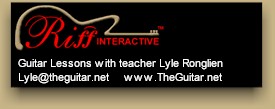Scroll through the lesson and click on notation/video/audio links to load the interactive players.
Please subscribe to get full access to all lessons for only $7.95/month PLUS 1 week free trial.

Riff Interactive lessons are
LESS expensive and
MORE interactive than alternatives!
More Info
|
|

Jam Sessions - Rock
Style II
Lesson 7 - Jam in C#m
Lyle:
This lesson has a simple rhythm riff in C#. I'll show you how to play it and
then teach you a few scales to improvise with against the jam track. Then you'll
learn a solo to practice.
Lyle: Here's your jam track in C#m:
Lyle:
Here's the rhythm guitar riff in the jam track:
Lyle:
Just a simple repeating riff with a heavy palm mute and muted scratching.
Lyle:
Use your bridge pickup with a heavy distortion.
Lyle: To help you get started jamming, try
learning the C# Dorian minor scale and play it against this jam.
Lyle:
Listen to the TAB file for the C# Dorian minor and you'll hear how melodic it
can sound with the jam track.
Lyle: Of course you can always play the popular
C# minor pentatonic scale too over this jam.
Lyle: Now that you have a few scale patterns to
use for improvising, I'd like to show you how to play the lead parts from the
lesson sample. Here's riff 1 which is from the C# Dorian minor scale. This uses
unison bends to make a fatter tone:
write: Lyle not
sure I understand why B Major works here when the minor is relative to E
major.
write:
Although B and E share most of the same notes.
Lyle: The reason I use the B major scale at the
end of the scale TAB is to show you how thinking in terms of what modes you can
use can help. B major scale is the I scale in the key of B major, C# Dorian is
the ii scale/mode in the key of B major.
write: In
Aeolian the half steps are between 2 and 3 and 5 and 6. In Dorian the half steps
are between 2 and 3 and 6 and 7. Is that correct.
Lyle: Yes that's right.
write:
I'm getting there.
Lyle: You can set the TAB to auto-loop to help
you memorize the riff.
Lyle: Riff 2 uses this C# Dorian
pattern:
Lyle: I
like using the Dorian minor whenever I get the chance. It has a funkier sound to
it than the natural minor.
Lyle: Here's the riff using this C# Dorian
scale:
Lyle: The next riff from the lesson sample is
made from the C# minor blues scale:
radica: riff 3
is killer
radica: What
does PM stand for on the tab?
Lyle: p.m. = palm mute.
Mike: For
a blues scale, riff 3 with the rhythm sounds almost like metal. Speed up the
scale and there you go
Lyle:
The 4th and final riff from the lesson sample is real simple. It uses the root
and 7th degree from the B major scale:
Lyle:
Put all 4 riffs together and you have what's being played in the lesson sample.
I try not to make real fast riffs or anything too crazy. I just want to give you
a good jam track that might inspire you to practice with and work on playing
riffs and scales and explore some theory.
Lyle: Next lesson I'll show you more modal riffs
to play against this jam track.
Lyle: Everything is a mode of
something.
radica:
Is
that how you approach your playing all the time?
Lyle: No, I don't think so. I try to go off
familiar patterns, major or minor, then narrow it down to what works
best.
Lyle: I try to use my ears first, brain
second.
BigDee: So
with Dorian you really want to play around with the 6 and flat 7 to accent the
Dorian modality? Compared to the flat 6 of the Aeolian with the flat 3 in common
with the two modes.
Lyle: That is correct.
BigDee:
cool!
Lyle:
Good time to take a break. See you again soon!
|
<< load notation from left
|
|
<< load audio from left
|
<< load audio from left
|